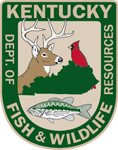 Bert T. Combs Lake in Clay County is back open to public boating and bank access after completion of repair work to its dam.
Bert T. Combs Lake in Clay County is back open to public boating and bank access after completion of repair work to its dam.
The 31-acre lake near Manchester was closed so crews could fix leaks throughout the earthen dam. The Kentucky Division of Water oversaw repairs to the dam.
The Kentucky Department of Fish and Wildlife Resources-owned lake is scheduled to receive a stocking of 1,000 rainbow trout this week. In 2019, rainbow trout will be stocked in January, April, May and October.
Resident and nonresident anglers who are required to have a fishing license must have a trout permit to keep trout. The permit costs $10. It also is included with the resident senior or disabled sportsman’s license and resident sportsman’s license.
The lake offers a boat ramp and parking area. Internal combustion motors are not allowed on the lake, but boaters can use electric motors. Paddling a kayak or canoe is another way to explore and fish the lake.
For more information about fishing opportunities and places to fish in Kentucky, visit Kentucky Fish and Wildlife’s website at fw.ky.gov. Anglers also may use this site to purchase fishing licenses online at any time of day.
 The Kentucky Department of Fish and Wildlife Resources encourages youngsters – and the young at heart – to put on their costumes and join the Salato Wildlife Education Center staff in Frankfort for the best trick-or-treat experience in town on Saturday, Oct. 27.
The Kentucky Department of Fish and Wildlife Resources encourages youngsters – and the young at heart – to put on their costumes and join the Salato Wildlife Education Center staff in Frankfort for the best trick-or-treat experience in town on Saturday, Oct. 27.
Salato’s annual Halloween Walk with the Animals event features child-friendly activities including a hay bale maze, “Creatures of the Night” exhibit, face painting and – of course – plenty of candy. Kids will receive a “passport” which they can get stamped at more than a dozen candy stations scattered throughout the grounds. Salato staff and volunteers will be on hand to answer questions and the center’s indoor and outdoor exhibits will be open for viewing. The event will also feature food and beverage vendors.
The center will open at noon (Eastern) for the event, which runs until 4 p.m. Event admission is $5 per person (ages 2 and up). Annual membership holders and infants too young to participate receive free admission.
The Kentucky Fish and Wildlife Foundation sponsors Halloween Walk with the Animals. Proceeds from the event benefit the Salato center.
Walk with the Animals not only allows families to enjoy the traditions of Halloween, but it provides a great opportunity for visitors to see and learn more about Kentucky’s native wildlife. “Halloween Walk with the Animals is a fun community event that we look forward to hosting each year,” said Kentucky Fish and Wildlife Foundation Director Rachel Crume. “This event provides a unique venue, as well as a fun and safe environment in which families can enjoy the holiday.”
The Salato Center is operated by the Kentucky Department of Fish and Wildlife Resources. The center is off U.S. 60, approximately 1½ miles west of the U.S. 127 intersection. Look for the bronze deer statue at the entrance of the main Kentucky Fish and Wildlife campus.
Normal hours are 9 a.m. to 5 p.m. Tuesday through Friday, and 10 a.m. to 5 p.m. Saturday. Salato is closed on Sunday, Monday and state holidays. The center will close for the winter after Nov. 21, then reopen in the spring of 2019.
Except for select events, admission is $5 for adults and $3 for youth 5 to 18. Children younger than 5 are admitted free. The center also offers annual memberships for individuals and families.
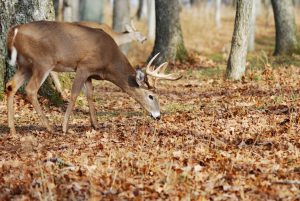
Photo: Kevin Kelly/Kentucky Department Fish and Wildlife
Many deer hunters rejoiced this past weekend over a break in a weather pattern that had been alternating between stifling heat and soaking rains.
A cool down coincided with the two-day gun season for youth deer hunters. It also excited archery and crossbow hunters getting into the woods, blinds and tree stands.
“It wasn’t really fit to do much but go hunting,” said Gabe Jenkins, deer and elk program coordinator with the Kentucky Department of Fish and Wildlife Resources. “We saw good participation over the weekend.”
On deck for deer hunters in Kentucky are the October muzzleloader (Oct. 20-21), modern gun (Nov. 10-25) and late muzzleloader seasons (Dec. 8-16) before the free youth weekend on Dec. 29-30, 2018.
Difficult hunting conditions defined the first six weeks since archery deer season arrived at the start of September, which also ushered in numerous changes to deer hunting regulations.
The changes are detailed in the updated version of the Kentucky Hunting and Trapping Guide, on the department’s website at fw.ky.gov and in videos posted on the department’s Facebook page and YouTube channel.
“What I’ve been telling people is, if you’re a deer hunter in this state, read the hunting guide because something that affects you has changed,” Jenkins said.
Major differences from last season:
- The statewide and youth deer permits allow for the harvest of up to four deer, either one antlered and three antlerless or four antlerless.
- The modern gun deer season is 16 days statewide.
- A total of 32 counties have been moved up into a different zone.
- Hunters can take as many deer as allowed for each zone. In order to take more than four deer statewide, an additional deer permit must be purchased.
- Hunters in Zones 2 and 3 can harvest no more than four deer. In Zone 3, only one antlerless deer can be taken with a firearm.
- The bag limit in Zone 4 is two deer but only one can be an antlerless deer. Antlerless deer can be harvested during the archery season, crossbow season, free youth weekend or the last three days of the December muzzleloader season. Again, the statewide bag limit of one antlered deer applies.
Hunters are still allowed only one antlered deer statewide regardless of zone, method or season. In Zone 1, hunters can still harvest an unlimited number of antlerless deer with the statewide deer permit and additional deer permit.
The changes encourage greater harvest of does and increased deer harvest in areas where a reduction in herd numbers is sought. At the same time, they are designed to foster a bounce back in areas of east Kentucky hit hardest by last year’s epizootic hemorrhagic disease (EHD) outbreak.
“The new regulations are intended to help meet those objectives,” Jenkins said.
Jenkins said this week there has been one confirmed case of EHD with test results pending on five others, most from north of Interstate 64 and east of Interstate 75.
“I wouldn’t be surprised if we see an uptick in harvest with people wanting to try to fill their four-deer limit,” Jenkins said. “But we also know that three-quarters of our total harvest comes during the modern gun season. That’s the key. If we get a bad weather weekend or two in there, that’s going to have an effect.”
Hunters harvested 136,026 deer during the 2017-18 season, the fifth highest total on record, and the state’s deer herd remains robust overall.
“Things are good,” Jenkins said. “We had a very wet winter and there’s plenty of forage for both adults and fawns, so we expect to see high survival. Traditionally, you have a stress period in July and August. That did not exist this year. They’ve had plenty of groceries on the landscape, so they should be in prime condition health-wise.”
While September’s harvest was down year-over-year, understandable considering the unkind heat and rain, it remained higher than the 10-year average.
Hunters reported taking 4,654 deer during this month’s youth-only gun season weekend, second only to the 2015 season.
That year, the statewide mast survey noted poor white oak acorn production with red oaks rated average. Early returns from mast surveys conducted this year point toward uneven acorn production. Deer will frequent areas around white oaks littering the ground with acorns first before turning attention to red oaks.
“They’re going be more active in weather like this than they are in 90-degree temperatures,” Jenkins said. “They’re going to do what they’re going to do breeding wise when the season is right. However, if conditions are more conducive to eat and be up and moving, they’re going to.
“Right now the key is acorns. Deer are just going to sit there and munch on acorns all day long.”
A chill in the air gets hunters thinking about deer in Kentucky. The best part is its arrival this year comes with plenty of season still left.
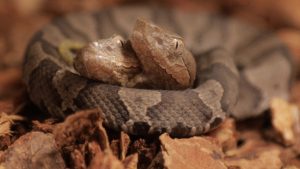 A two-headed copperhead snake born in the wild less than one month ago is now in the care of the Salato Wildlife Education Center and will be available for limited public viewing at the facility in Frankfort.
A two-headed copperhead snake born in the wild less than one month ago is now in the care of the Salato Wildlife Education Center and will be available for limited public viewing at the facility in Frankfort.
A Leslie County couple donated the rare snake for educational purposes after discovering it in their yard this month.
“I may encounter a two-headed snake in the wild every two or three years but a two-headed copperhead is a first for me,” said Kentucky Department of Fish and Wildlife Resources State Herpetologist John MacGregor, a leading expert on snakes in Kentucky. “It is a really interesting animal to have on display and a unique opportunity for the public.”
The copperhead is one of four species of venomous snakes found in Kentucky. The others are the cottonmouth, timber rattlesnake and pygmy rattlesnake. Of those, the copperhead and timber rattlesnake are the most common in Kentucky.
A two-headed copperhead snake is extremely rare and its life expectancy in the wild typically is short because of physical limitations caused by the mutation.
“One big question is if the throat connects to the rest of the intestinal tract,” MacGregor said. “That is sometimes a problem with two-headed animals; neither head is completely formed, and there is no way they can swallow anything. Sometimes one head works and the other head does not. With this snake, both tongues work, so there is a pretty good chance that both are functional.”
The snake’s well-being is a top priority for the Salato Center’s staff.
As long as it appears to be in good health, the snake will be available for public viewing 10 a.m. to noon and 2 p.m. to 4 p.m. starting Friday, Oct. 19.
Public viewing times are subject to change and do not include the Salato Center’s annual Halloween Walk with the Animals event scheduled Saturday, Oct. 27. Viewing times on the day of that event have not been determined.
“Salato is thrilled to host this unique animal,” said Heather “Teach” Teachey, Salato Center director. “We hope the snake will thrive under our care and be an educational ambassador of a native Kentucky species.”
The Salato Center is open 9 a.m. to 5 p.m. Tuesday through Friday, and 10 a.m. until 5 p.m. on Saturday. It is closed on Sunday, Monday and state holidays. Admission is charged for visitors ages 5 and older. Visitors can confirm if the snake is available for viewing on the day of their visit by calling 1-800-858-1549.
The Salato Center, operated by Kentucky Fish and Wildlife, is off U.S. 60, approximately 1½ miles west of the U.S. 127 intersection. Look for the bronze deer statue at the entrance of the main Kentucky Fish and Wildlife campus.
The Salato Center will be closed for the winter after Nov. 21.
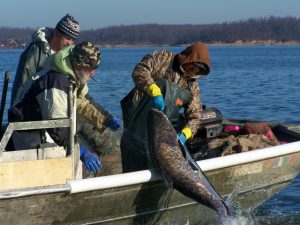 Gov. Matt Bevin today announced the award of the state’s first-ever fish house contract, in an innovative step to attack the Asian carp problem in western Kentucky and encourage job growth in the region. Bevin announced that Kentucky Fish Center, LLC of Wickliffe, Ky. has won the contract to establish the fish house, which will expand the market for Kentucky-caught Asian carp.
Gov. Matt Bevin today announced the award of the state’s first-ever fish house contract, in an innovative step to attack the Asian carp problem in western Kentucky and encourage job growth in the region. Bevin announced that Kentucky Fish Center, LLC of Wickliffe, Ky. has won the contract to establish the fish house, which will expand the market for Kentucky-caught Asian carp.
Angie Yu, operator of Two Rivers Fishery, a fish processing company also based in Wickliffe, will own and operate the Kentucky Fish Center. Asian carp caught in Kentucky will be sold by Kentucky Fish Center in daily auctions open to all interested buyers. The Kentucky Department of Fish and Wildlife Resources will oversee the auctions.
“The Tourism, Arts and Heritage Cabinet has worked tirelessly to develop a workable solution for mitigating Asian carp,” said Gov. Bevin. “Today’s announcement is a great example of government partnering with the private sector to create a commonsense, market-based solution. It will provide commercial anglers with new opportunities, while also removing this invasive species from Kentucky’s waterways.”
By buying carp caught in Kentucky waters at a guaranteed price of 19 cents per pound, and selling the fish to both domestic and international users in daily auctions, the fish house will play a key role in growing the market for Kentucky carp.
The Kentucky Department of Fish and Wildlife Resources is pledging up to $4 million in loans and incentives for the fish house and commercial fishermen. The department will pay commercial anglers an incentive of 5 cents per pound for their catch, supplementing the fish house’s guaranteed 14 cents per pound purchase price, to make fishing for carp in Kentucky’s waters economically attractive.
“Commercial anglers currently harvest two million pounds of Asian carp from Kentucky’s waters each year,” said Ron Brooks, Kentucky Fish and Wildlife’s fisheries director. “We believe this program can increase that catch to 20 million pounds across the state within the next five years.”
Asian carp first came to the United States to help control aquatic weeds and algae blooms in fish farms. By the 1980s, three species of Asian carp had escaped into the wild during floods. They have now spread throughout lengthy portions of the Mississippi, Ohio, Missouri and Illinois rivers. They have established significant populations in Kentucky and Barkley lakes.
Asian carp include bighead, silver, grass and black carp. They are prolific breeders. A single large Asian carp may produce up to a million eggs yearly. An Asian carp can consume 5 to 40 percent of its body weight each day. Bighead and silver carp feed voraciously on the same plankton that young sport fish such as crappie depend upon for their survival. Silver carp also jump from the water upon hearing the approach of a motor, creating hazards for boaters.
Commercial angling is the only practical method for limiting and reducing Asian carp numbers. Currently, only a handful of commercial anglers operate on Kentucky and Barkley lakes.
The incentives offered under the new distribution center contract will guarantee anglers a buyer and a nearby place to offload their catch. Brooks said the arrangement should lure more commercial anglers to Kentucky and Barkley lakes.
“We believe this will increase the amount of Asian carp coming out of those lakes to five million pounds per year,” Brooks said. “A sustained harvest of this amount will significantly reduce the impact of Asian carp on these nationally-recognized crappie lakes.”
The program includes a $734,000 secured loan for fixed assets to assist with the start-up of the fish house. Performance-based incentives of $570,000 to $700,000 a year will be awarded if the escalating yearly harvest goals of 5 to 20 million pounds of fish are met. The secured loan would be forgiven in 2024 if the 20 million pound goal is met that year. The program will be fully funded by boat registration fees.
Department officials estimate the effort would cost $3.5 million a year if it were run entirely by the state and would produce a harvest far less than the 20 million pound goal of the partnership announced today.
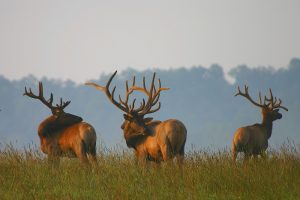
Photo: Kentucky Department Fish and Wildlife
Hunters interested in entering this year’s elk hunt drawing have until midnight (EST) April 30 to buy applications. Hunters can apply online at the department’s website, fw.ky.gov.
Kentucky residents and non-residents are eligible to apply for four permit types but can only be drawn for one. Each application costs $10.
Kentucky Fish and Wildlife will issue 700 general quota hunt permits and 10 youth permits this year through a random computer drawing conducted in early May by the Kentucky Commonwealth Office of Technology. Results will be available to applicants on the department’s website May 15.
Sixty-four percent of bull elk hunters using a gun last year enjoyed a successful hunt and 48 percent of hunters utilizing archery equipment successfully harvested a bull. The success rate for cow archery hunters was 28 percent last year and 47 percent among hunters using a firearm for cow elk.
“Our herd is strong and healthy,” said Gabe Jenkins, deer and elk program coordinator with the Kentucky Department of Fish and Wildlife Resources. “However, the herd dynamics have changed in recent years. Hunters will have to work to be successful and time spent scouting will greatly increase chances for success.”
The season limit of 250 bulls and 450 cow elk is unchanged from last year, as is the allotment among tag types.
Kentucky Fish and Wildlife will issue 150 firearms permits and 100 archery/crossbow permits for bulls; 290 firearms permits and 160 archery/crossbow permits for cow elk.
Demand is greatest for the bull firearms permit and lowest for the cow archery hunts.
The bull archery/crossbow season opens in September. The bull elk firearms seasons are spread over two separate, weeklong hunts in October while the cow elk firearms seasons are split into two weeklong hunts, both in December.
Hunters ages 15 and younger also can apply for the youth-only quota hunt during the same application period as the general elk quota hunt drawing. They may apply for the general quota elk hunt drawing as well, but cannot be drawn for both in the same year.
A landmark restoration effort re-established an elk herd in the state’s scenic southeastern region and created one of the most sought-after hunting opportunities east of the Rocky Mountains. Kentucky’s elk herd is the largest east of the Rocky Mountains and more than all the states east of the Mississippi River combined. The elk restoration zone in southeast Kentucky covers 16 counties and more than 4 million acres.
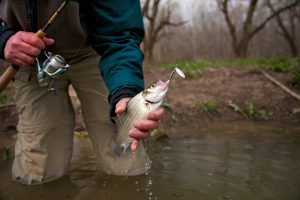
Photo: Kentucky Department Fish And Wildlife
This spring seems like one long continuation of late winter. As soon as we get a warm day, the temperature plunges and we are back in February again. It even snowed on Monday of the third week of April.
This up and down weather combined with cold rains has the spring fishing season behind by a few weeks. The spawning runs of white bass into the headwaters of reservoirs are scattershot so far this spring, with some movement followed by retreat.
“I don’t think the white bass have really had a chance to run yet,” said Ron Brooks, director of Fisheries for the Kentucky Department of Fish and Wildlife Resources. “I think the fluctuating water temperatures are screwing them up a bit. We need a sustained warm front to get them going.”
Water temperatures are in the low 50s in most reservoirs and streams across Kentucky.
Anglers fishing the headwaters of Taylorsville Lake found rewarding, but sporadic, fishing over the last week. “Last Thursday, I took home six white bass, but on Friday, I took home 10, at least four of them over 15 inches,” said Clifford Scott, internal policy analyst for Kentucky Fish and Wildlife. “I had to walk quietly out of there because I had the biggest stringer of fish.”
Scott took his fish with a combination of old-school 2-inch curly-tailed grubs in white and yellow along with a 2-inch Bobby Garland Baby Shad in pink and pearl.
“I saw small shad all over the place,” Scott said. “Once I saw them, I switched to the Baby Shad. You had to fish for the white bass, they were not on a hard run, but produced enough action to keep your interest.”
The upper part of Taylorsville Lake WMA grants bank access to anglers that produces fishing comparable to those in boats.
Mike Hardin, assistant director of Fisheries, caught some white bass in the upper reaches of Taylorsville Lake this past weekend. “We caught them above the first riffle from the impounded water,” he said. “We caught a mixed bag of different sizes and caught more in the evening than in the morning. The males were marked up in breeding colors. We caught a few females, so they are already staging for the spawn.”
White bass populations are by nature cyclic, and good fishing often erupts in lakes over the course of a year or two.
Green River Lake is one of those lakes poised for a white bass breakout. Southwestern Fisheries District biologist Eric Cummins and crew conducted white bass population sampling on the lake last year. They found excellent reproduction in 2014 for white bass, producing an expanding population of fish 14 inches and longer in the lake.
Last week, some bass anglers fishing a tournament on Green River Lake reported incidental catches of white bass while fishing crankbaits for largemouth bass. Anglers should search the Robinson Creek arm from Wilson Creek up to the KY 76 Bridge (Knifley Road) and in the Green River arm above Holmes Bend.
Bank anglers can access the upper end of the Robinson Creek arm at the Elkhorn Ramp and the Wilson Creek Recreation Area. They may also access the upper section of the Green River arm at the Snake Creek Ramp and other roads on the Green River WMA in that area.
Cave Run Lake is another reservoir with growing numbers of white bass. Population surveys conducted in 2017 show high numbers of larger fish, which should mean good fishing in 2018. Search for surface activity to find white bass in spring on the lake.
The fishing peaks in summer on Cave Run, when white bass get in the “jumps” by trapping shad against the surface and ripping through them. The confluence near the mouth of Buck Creek as well as the areas around the Clay Lick and Alfrey boat ramps make excellent places to search for them when it gets hot. Any shad imitating topwater cast into the jumps will get smoked.
Some anglers caught fish in the Broad Ford area in the headwaters of Nolin River Lake a few weeks ago, but the fishing slowed with the cold rains that accompanied major frontal passages earlier in April. The sustained warm weather in the upcoming forecast will draw waves of white bass into Nolin River Lake above Bacon Creek Ramp.
Fast and furious fishing during the spring runs makes white bass one of the most popular fish anglers pursue. When they are on, you can catch several fish on consecutive casts.
In-line spinners like the venerable Rooster Tail in white, chartreuse and pink all score white bass. You can work an in-line spinner near the surface or let it sink a few feet and retrieve. Vary the depths of the retrieve until you hit fish.
Like what Scott found last week, small shad-shaped soft plastic lures or curly tailed grubs also attract white bass. Some anglers fishing the headwaters of reservoirs suspend 1/16- to 1/32-ounce white feather or hair jigs under bobbers and let them drift in the current. Change the depth of the jig until you find white bass.
Anglers may keep 15 white bass daily, but only five of the daily limit may be longer than 15 inches. White bass fishing gives you a fantastic reason to buy your fishing license, so don’t forget to get one if you haven’t already.
 Weather
Weather Traffic
Traffic @LouisvilleDispatch
@LouisvilleDispatch @LouisvilleDisp
@LouisvilleDisp Subscribe
Subscribe